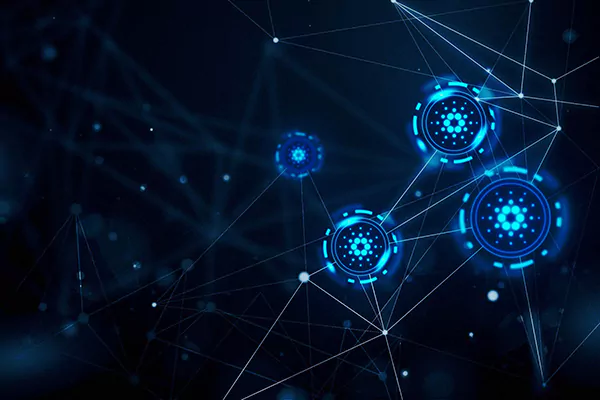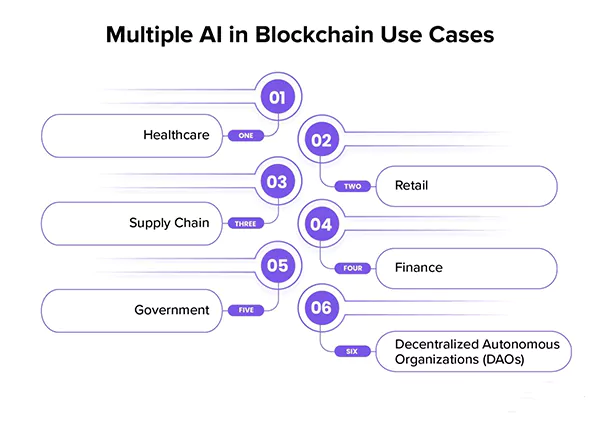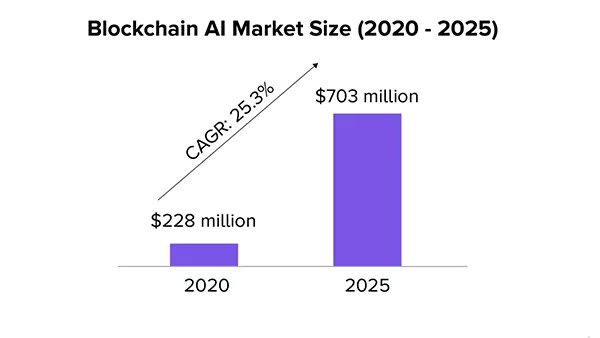
Artificial Intelligence (AI) and Blockchain are two of the most innovative technologies that have become quite the trend in the last couple of years.
And, many companies that provide blockchain app development services are curious to see what these two can accomplish if combined.
In this article, we will explore the depths of AI and blockchain and find out the present trends, obstacles, and opportunities for innovation in this lucrative industry.

Well, this technology is primarily used in cryptocurrencies, including the Bitcoin too.
But now blockchain app development companies use it across many industries like supply chain management, healthcare, and fintech.
So, what exactly is the blockchain?
It is primarily a decentralized ledger system that allows users to maintain a secure and tamper-proof ledger without the need for any central authority to maintain it.
It relies mostly on cryptography to create digital records or blocks that link together in a chain, and every block contains a unique hash or address that points to a previous block.
This makes sure that any attempt to alter the data stored in these blocks will be immediately caught and rejected by the network.
It means that machines can do work that usually needs a human mind like reasoning, learning, and decision-making.
AI technologies use different kinds of algorithms and machine learning models to analyze huge amounts of data and identify patterns that a human could have missed.
It analyzes data to make many predictions and recommendations that can automate many processes and improve efficiency.
This can also improve the decision-making process.

Blockchain and AI combination applications are almost similar across all businesses.
Some examples of AI-based applications include chatbots, VR assistants, NLP models, predictive analysis, etc. The Intersection of Blockchain and Artificial Intelligence
Since all the transaction information is stored in the blockchain at multiple locations, this can be used to train the AI to improve security.
For example, a blockchain-based application sends transaction data to an AI to create patterns for the user’s financial behavior and monitor real-time changes.
And if there is any change in behavior like suddenly doing a cash withdrawal or the transaction amount is more than usual, then the system may put a stop to the transaction or ask the user to confirm their identity by password.
Well, AI relies solely on a central server infrastructure.
By using the blockchain, we can let the AI’s source code be stored on multiple nodes on the server network instead of on a single server.
This could very easily solve the issues of the AI being inaccessible and any system failures since the system could continue working even if one of the nodes fails or shuts down.
This also means that the server will still keep working even if it’s going through server maintenance because of the cascading shutdown of nodes during preventative maintenance.
Smart contracts of the blockchain can help in automating the transactions and make sure that the data usage complies with the agreed terms.
This ensures a transparent and trustworthy data exchange.
For example, if there is a startup that needs to train an AI that can detect cancer, they can use the marketplace to buy the data they need from various cancer centers.
Blockchain and AI have a great potential for use in IoT.
They can collect and store data securely from multiple sources.
This can include satellites, wearables, weather services, etc.
This massive amount of data allows the AI to operate on many inputs to provide the best responses as needed.
For example, AI plays a role in the financial industry by using the collected data and real-time monitoring to forecast price surges for cryptocurrency and other assets.
AI models can also identify any possible network congestion from past data and forecast any periods of high traffic on the network.
This means that the validators can implement preventative measures for such cases, like adjusting the gas fees or temporarily increasing the number of validators to manage the congestion.
For example, during times of high traffic, it takes longer to confirm a transaction, and also, the network speed takes a hit too.
By analyzing the data processed by the AI, network participants can identify which transactions must be prioritized.
This allows them to increase the gas fees as needed, and it also gives the miners an incentive to reallocate computing power to process high-priority transactions more quickly, improving overall network efficiency.
One of the biggest issues for blockchain is its scalability.
Adding more transactions to the blockchain slows down the network speed and increases the maintenance difficulty.
This can be pretty tricky for AI applications which need fast data processing for massive data loads.
Blockchain networks are very fragmented and oftentimes need interoperability.
This creates a unique challenge for AI applications that need access to multiple data sources to work more efficiently.
Blockchain technology can be pretty expensive.
This is especially true for large-scale use cases.
Also, many organizations might need help to justify the investment necessary to integrate AI solutions into a blockchain network.

The blockchain AI market size is said to increase from $228 Million in 2020 to $703 Million by 2025.
Speaking of standardization, there are currently no standards set in place for the construction and deployment of AI apps in the blockchain network.
This limits the ability of the devs to create interoperable can compatible systems.
This can reduce the application efficiency too.
Connecting AI and blockchain has the potential to change business operations forever.
The blending of these two technologies can bring about many benefits for a business like improved data privacy, security and transparency, etc.
This can bring innovation and change in the whole of the business industry.
